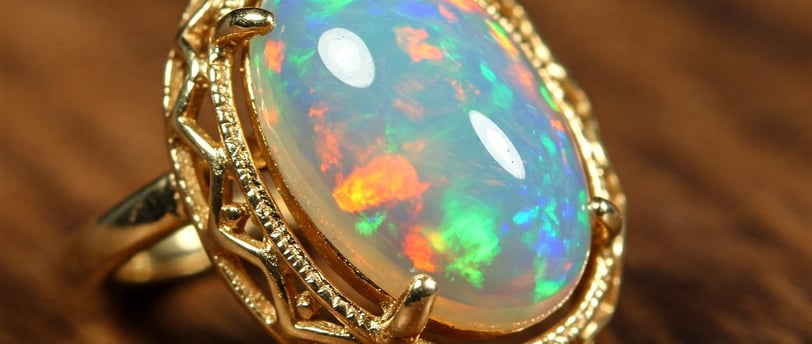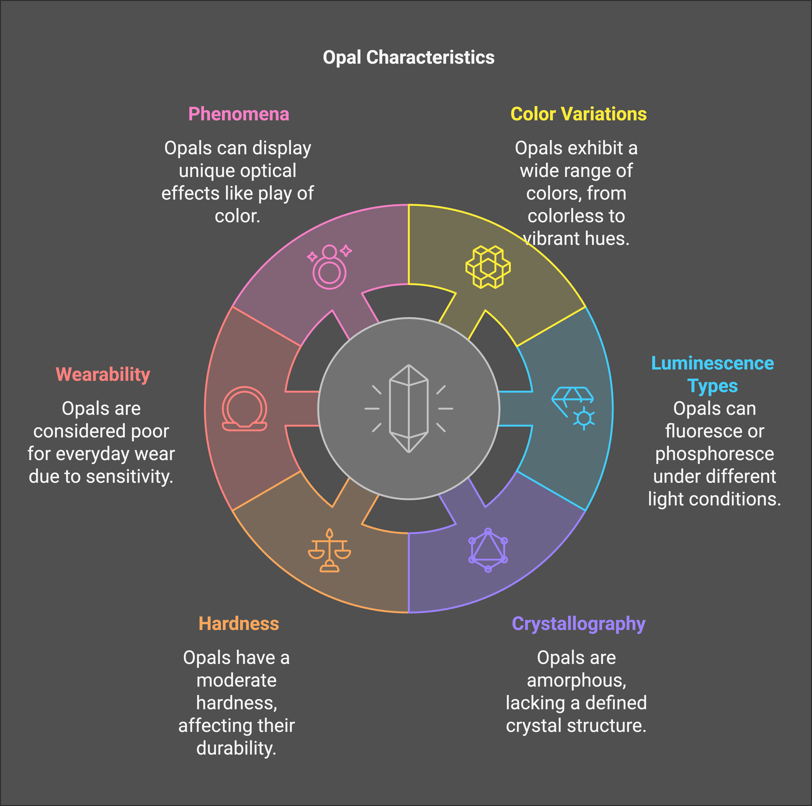Opal
Opals, known for their unique play of colour, are a diverse and fascinating group of gemstones. This guide provides an overview of the key factors influencing their value and beauty.
1/30/20255 min read


History
For thousands of years, opals have been mined and treasured. The ancient Romans believed that opals were the most precious and powerful of all gems, because they encompassed the colours of all other gems. They are the traditional birthstone for October and are associated with a rich body of folklore, considered by some to be both lucky and unlucky stones to wear. Some scholars, however, believe that many ancient references to opal may actually have been to other gems, such as the iridescent iris agate. In the 1890s, when Australia's mines began producing opals commercially, they quickly became the world’s primary source for this October birthstone.
Mineral Origins
Opal is an amorphous form of silica. It is chemically similar to quartz but contains between 3% and 21% water within its mineral structure, with gem-grade opals usually having a water content of 6% to 10%. Opals are formed in sedimentary rocks when water, rich in dissolved silicates, enters a cavity and deposits the silicates as microscopic spheres. When these spheres are uniform in size and neatly stacked, they diffract light, resulting in the phenomenon known as play of color, which is a hallmark of precious opals. In contrast, common opals form when these spheres are random in size, shape, and arrangement, and do not exhibit play of color.
The 4 C’s
Like other gemstones, opals are evaluated based on the 4Cs: colour, clarity, cut, and carat weight. However, some unique factors also come into play.
Colour
Colour is the most important factor when evaluating an opal's value. The more colours that are present, the more valuable the opal is. Blues and greens are the most common colours, whereas warm colours like yellow, orange, pink, and red are less common and, therefore, more valuable. Violet and purple are the least common, but they don't impact value as much as a hot red or orange.
Clarity of colour is also important, with bright, pure colours being more valuable than lighter or greenish hues. The brightness of an opal's fire or play of colours is graded on a scale of 1 to 5, with level 5 showing exceptionally bright, crisp colour in all lighting situations. Additionally, coverage is crucial; ideally, the entire crown of the gem should show fire, and the best play of color should be centred. The less area covered, or if the best play of colour is off-centred, the lower the value of the opal.
Body tones also play a role in the colour evaluation. Gemologists use a system to distinguish between black, dark, light, and white opals, ranging from N1 (black) to N9 (white). Stones from N1 to N4 are considered black opals; N5 to N6 are considered dark opals; N7 to N8 are considered light opals, and N9 is considered a white opal.
Clarity
Clarity in opals is evaluated differently than in other gemstones. It refers to the degree of transparency and freedom from inclusions. True inclusions include sand, non-opal spots, healed fractures, chips, and webbing. The impact of these inclusions on clarity and value is directly related to their effect on the appearance of the gem. For example, sand on a black opal or black potch showing through a layer of light opal is considered very unsightly and significantly reduces its value. Fractures will reduce the value of an opal to nearly nothing. While fine black potch webbing is of minor consequence, matrix (the host rock) appearing on the surface has a negative impact on the value.
Carat
While carat weight does affect value, high-carat stones do not command as high a price as mid-size stones. The highest values are given to gems between five and ten carats. Opals have a relatively low density, meaning that even larger sizes can be comfortable to wear.
Cut
The cut of an opal affects its value and appearance. High-quality opals should have a very good to excellent polish. The value of an opal decreases if it is very thin or excessively thick and if the cut is uneven. Like other cabochons, opals should be symmetrical when viewed from the sides and ends. However, symmetry doesn't affect the value of an opal carving. Standard shapes are generally preferred, although some freeform opals with unique shapes can increase value.
Be Aware of
Enhancements
Opals may be treated to enhance their appearance, and these enhancements should always be disclosed before a sale. Common treatments include oil, wax, or plastic impregnation, which improves the play of colour and disguises crazing, but these treatments often have poor stability. Other treatments include black plastic impregnation, which gives the appearance of a black opal, smoke impregnation to darken the body colour, and aniline dye, silver nitrate, or sugar treatments, which also darken the body colour.
Simulants
Simulants are imitations that are made from plastic or glass that simulate the appearance of opals but are not real opals. Plastic simulants are soft and can be probed with a sharp needle, while glass simulants often contain bubbles and swirl marks, and they also do not phosphoresce.
Synthetics
Synthetic or lab-created opals are real opals, but they are grown in laboratories instead of underground. They undergo the same formation processes, but at an accelerated rate in controlled settings. Synthetic opals may show a strong display of colour, often in a mosaic pattern, and under high magnification, they may show a cellular, scale-like, or chicken wire structure. They also do not phosphoresce.
Final Thoughts
Buying Tips
When buying an opal, it is important to consider the directionality of flashes, as the play of colour can depend on the viewing angle. Ideally, the viewer should see bright, attractive patterns from every direction. It is also important to remember that the "face" of an opal receives the grade; the condition of the back isn't factored into its grade or value. Also, consider that some opals have "character," meaning their appeal is greater than others with the same technical grade.
Consumers may see higher or lower value in an opal than its professional grade may indicate, and prices are subject to negotiation, as long as buyers understand the technical evaluation. When it comes to patterns, pinfire and small-type patterns add less value to opals than broad patterns or large flashes, with distinct patterns like rolling fire, straw, Chinese writing, ribbon, and harlequin being highly prized by collectors. Picture stones, especially if they resemble a known site, are the most valued of all.
Jewelry Care
Opals are delicate and sensitive to shocks and changes in temperature. They are also susceptible to scratching, with a hardness of only 5.5 to 6.5. As such, they require special care and should be stored carefully to avoid scratches. They are not recommended for ring stones unless placed in a protective setting or reserved for occasional wear. It is important to keep them away from extreme light, heat, and dryness to prevent them from cracking. They should be cleaned with warm, soapy water and should not be exposed to acid.


Gemius Stones
Expertise
© 2025. All rights reserved.
